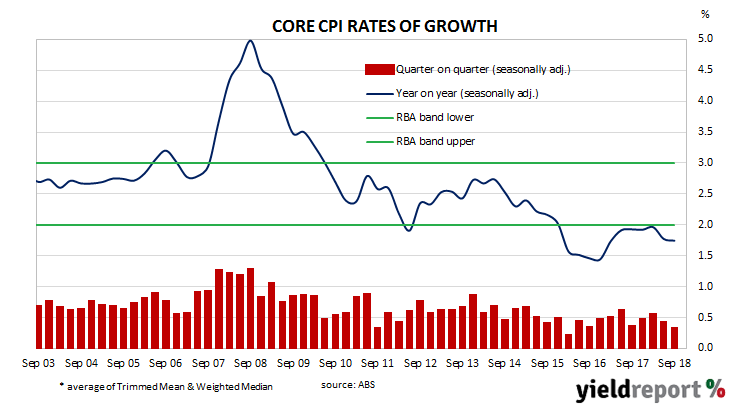Inflation was once a problem in Australia. Through the 1970s and 1980s, consumer inflation regularly exceeded 5%, even though real GDP growth rates were on the low side and were far from buoyant levels. This combination of high inflation rates and low economic growth rates was termed “stagflation” and it existed in most advanced economies at the time.
In 1990/1991, inflation in Australia was broken by a deep recession which would become known as the “recession we had to have”, in reference to the then-Treasurer Paul Keating’s description of it. Since June 1991, inflation rates as measured by changes in the consumer price index have averaged around 2.4%.
Figures for the September quarter have now been released by the ABS and the headline number was weaker than the expected 0.5% increase, as was the seasonally-adjusted figures. Headline inflation was 0.4% for the quarter while seasonally-adjusted inflation came in at just 0.1%. On a 12-month basis, headline inflation registered 1.9%, down from 2.1% in the June quarter, while the seasonally-adjusted rate fell back from 2.2% to 1.9%.
 “Core” inflation measures favoured by the RBA, such as the average of the “trimmed mean” and the “weighted median”, slipped on both a quarterly and annual basis. The average of the two measures were in line with the market’s expected figures of 0.4% for the quarter and 1.7% for the year.
“Core” inflation measures favoured by the RBA, such as the average of the “trimmed mean” and the “weighted median”, slipped on both a quarterly and annual basis. The average of the two measures were in line with the market’s expected figures of 0.4% for the quarter and 1.7% for the year.
Financial markets reacted in a muted fashion. Australian Government bond yields finished the day higher, generally in line with offshore leads. 3-year bond yields finished 2bps higher at 2.05% while 10-year yields were 5bps higher at 2.64%. The local currency had been reasonably steady before the release of the figures but as soon as the numbers appeared the Aussie fell from 71.00 US cents to 70.75 US cents and then settled at around 70.90 US cents. Changes to cash futures prices implied a reduced likelihood of an RBA rate rise in any given month through 2018 and 2019, with August 2019 now viewed as just a 22% probability.

